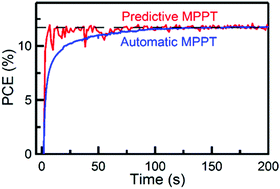Among the variety of approaches, such as current density–voltage (J–V) measurements with different voltage scan directions and rates, steady-state efficiency measurements, and maximum power point tracking (MPPT), MPPT is the most reliable method for characterizing the efficiency of organic–inorganic lead halide perovskite solar cells with strong hysteretic behavior. However, MPPT based on the commonly used simple perturb-and-observe (P&O) algorithm can still significantly underestimate the true maximum power point if the hysteresis is severe and a relatively small dwell time at each bias step is used. Here, we present a predictive P&O algorithm to model the current data which allows the prediction of the steady-state current density for each bias set point. As a result, our predictive MPPT speeds up the tracking process and measures the true maximum power point, regardless of the degree of hysteresis, suggesting a useful approach for characterizing the performance of hysteretic solar cells.

